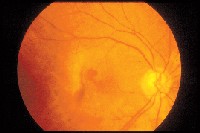 |
Q: Now that the FDA has approved Macugen, will most patients who have exudative (wet) age-related macular degeneration with choroidal neovascularization be offered this treatment? Or, is photodynamic therapy still a viable option?
A: Macugen (pegaptanib sodium, Eyetech/Pfizer) is the first of a new wave of therapy that targets the mechanisms of choroidal neovascularization (CNV). Others nearing approval include Lucentis (ranibizumab, Genentech) and Retaane (anecortave acetate, Alcon).
Macugen and Lucentis are anti-VEGF (vascular endothelial growth factor) drugs. They inactivate VEGF, a protein involved in the development of neovascularization. Both are injected intravitreallyevery six weeks for Macugen and every four weeks for Lucentis. Retaane is a corticosteroid that blocks the pathway in the angiogenic process. It is administered as a juxtascleral depot injection every six months.
Regardless of the type of treatment, waste no time in referring patients for evaluation who have wet age-related macular degeneration (AMD) and those who have CNV, says optometrist Mark T. Dunbar, director of optometric services at Bascom Palmer Eye Institute in Miami, and author of Review of Optometrys Retina Quiz column.
Early detection is key, and early treatment is optimal in preventing severe or any vision loss, Dr. Dunbar says. For instance, more than 87% of patients injected with Macugen showed stable or improved vision at three months after treatment, and 27% of eyes improved three or more lines of visual acuity.1
Whether new treatments such as Macugen will overshadow or replace photodynamic therapy (PDT) remains to be seen. PDT with Visudyne (verteporfin, Novartis Ophthalmic) is approved specifically for subfoveal CNV. Macugen is FDA approved for all neovascular AMD subtypes.
Regardless, treatment with Macugen and with PDT have yet to be studied head-to-head, says retinal specialist Elias Mavrofrides, M.D., of the Florida Retina Institute, in Lake Mary, Fla.
Furthermore, many retinal specialists administer PDT with Visudyne in combination with Kenalog (triamcinolone acetonide) injection. When we do those together, we often get better results than doing either one of those treatments alone, Dr. Mavrofrides says.
 |
| Neovascular AMD has one new treatment FDA-approvedMacugenand others are coming. |
This begs the question: Is Macugen as good as PDT or PDT plus Kenalog? At this point, its not really clear if Macugen is better than either of those two treatments, he says.
However, PDT and Kenalog may be a more appropriate treatment in certain cases, and Macugen may be a more appropriate choice in others, Dr. Mavrofrides says.
For now, Dr. Mavrofrides first line of treatment is PDT with Kenalog. He currently reserves Macugen for patients who cannot tolerate Visudyne or those who may have a problem with Kenalog. Glaucoma patients, for instance, may not be candidates for Kenalog, which may cause elevation of intraocular pressure and glaucoma progression.
Additionally, PDT is contraindicated with certain subtypes of wet AMD. For example, a patient with purely pigment epithelial detachment can worsen with PDT and Visudyne. So, Macugen or one of the other soon-to-be-approved drugs may be a better choice.
Also, research indicates that patients with minimally classic subfoveal CNV showed no improvement with PDT and Visudyne.2
One of the major points in favor of Macugen is that it appears to have some benefit no matter which subtype, Dr. Mavrofrides says.
Its possible that Macugen, Lucentis or Retaane used in combination with PDT could have a synergistic effect, Dr. Mavrofrides says. In other words, the combination of treatments could be more effective than any treatment used separately. The best way to combine these treatments is still under investigation.
His advice: I would encourage optometrists to be keenly aware that there are multiple treatment options. And, if optometrists identify patients with wet AMD, be sure to refer those patients to someone who can differentiate among those multiple options. This most likely will be a retinal specialist who is knowledgeable of (or participating in) the studies of all the various treatments.
Q: What involvement will optometrists have in comanaging these patients, or in monitoring their condition?
A: Patients with wet AMD and CNV should be followed closely by the retinal specialist, who will perform regular evaluations with fluorescein angiography and/or optical coherence tomography to watch for fluid and recurrence, Dr. Dunbar says.
If the patient is treated with Macugen, he or she will need to return to the specialists office every six weeks for perhaps two years. Within about a week after each injection, the patient will need to be examined for possible risk of infection (endophthalmitis) or retinal detachment from the injection. (Note that fewer than 1% of subjects in clinical trials experienced adverse events of endophthalmitis, retinal detachment and iatrogenic traumatic cataract.)
If circumstances warrant (for instance, if the patient lives far from the retinal specialist), the referring optometrist may see the patient for these routine evaluations, Dr. Dunbar says.
The big question now: Will this new wave of treatments be used for prevention in patients at risk for CNV? Studies should be underway soon. This is the next exciting frontier, both Drs. Dunbar and Mavrofrides say.
1. Eyetech Study Group. Preclinical and phase 1A clinical evaluation of an anti-VEGF pegylated aptamer (EYE001) for the treatment of exudative age-related macular degeneration. Retina 2002 Apr;22(2):143-52.
2. Photodynamic therapy of subfoveal choroidal neovascularization in age-related macular degeneration with verteporfin: one-year results of 2 randomized clinical trialsTAP report. Treatment of age-related macular degeneration with photodynamic therapy (TAP) Study Group. Arch Ophthalmol 1999 Oct;117(10):1329-45.

